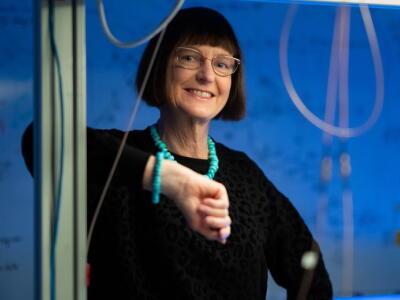Nanda's badge of pride in Australian nuclear physics
Posted on
Professor Nanda Dasgupta feels the word nuclear could do with a rebrand.
"There is so much hostility and fear around the word nuclear, and yet it's in everything and everywhere," she says.
"Bananas have radioactivity. Salt, milk, our bones contain radioactivity. Without nuclear processes, the Earth would be uninhabitable."
While there is currently much focus on nuclear sciences' role in defence, the field has a far wider application, and it is this diversity that appeals to Nanda. Nuclear and radiation sciences, underpinned by quantum physics, are used for medical diagnostics and treatment, space exploration, food safety, tracking soil erosion and providing information on climate change.
"The nucleus, at the core of an atom, is the one thing that doesn't change in the extremes of environment encountered by our planet throughout its existence - it is among the most isolated quantum system you can come across," Professor Dasgupta says.
"It can thus be used as a stable clock running over millions of years."
Professor Dasgupta is the Director of the NCRIS-supported Heavy Ion Accelerator Facility (HIAF) at the ANU, the largest and highest voltage ion accelerator in Australia (and one of three in the world).
Housed inside a 40-metre monolith, the facility provides the ability to see inside an atom, and is used for frontier nuclear and quantum science, creating novel materials, developing detectors for dark matter searches, and for finding the most efficient ways of creating new elements.
Professor Dasgupta describes the depth of her understanding of and connection to nuclear physics and ion accelerators almost like a relationship.
"While at school, I had wanted to join the Indian civil service, to change the country, make a difference. Then I got a scholarship to the Tata Institute of Fundamental Research in India to do a PhD in fusion, using its particle accelerator, and that drew me in," she says.
"Upon completion of my PhD I came to ANU for two years - 30 years ago. In that time, I've worked alongside my colleagues at the HIAF as part of every improvement so that it can continually drive cutting-edge, world-leading research.
"We know the accelerator facility wholly and completely."
Building and maintaining the HIAF can be seen as impressive foresight on behalf of ANU founders and subsequent research school directors, as it's central to Australia's training in nuclear physics, and Nanda says it's absolutely crucial - "this infrastructure is what attracts excellence," she says.
"Nuclear physics has a strong international focus and if the HIAF wasn't here, we would not have the capability or credibility to teach and train researchers at the world's best level."
Professor Dasgupta is looking to the future of nuclear science and industry engagement with excitement and positivity - as well as with a view to improving diversity in the field.
"We can't afford to leave half the population not engaged. We simply do not have enough people in Australia to have only part of society engaged in this endeavour," she says.
As someone who is frequently asked about women in science, Nanda says biases are still there - reducing perhaps, and not so explicit, but still present.
"We might say politically correct things, but to make a fundamental change requires action. For example, anecdotally I don't see a proportional increase in more childcare centres when we build more offices," she says.
"I feel 'women in physics' shouldn't be a question nowadays but it is. Men are never asked about being a 'man in physics'. It seems to me these systemic things are hard to overcome, and I feel it very passionately.
"I am now at a senior enough level that I ask myself, how do I make it better for the next person, and how do we make our workplace truly inclusive."
For Professor Dasgupta, it's an exciting time to work in Australian science.
"At HIAF, our ability to combine new ideas with clever and novel instrumentation and analysis delivers world-class and unique capabilities," she says.
"Scientists from around the world come to Australia to use HIAF. It is Australian capability, innovation and techniques that are sought after. In my mind, it is a badge that we wear with immense pride.
"But more than that, this is our time to lead a national effort in the long term, that brings Australian universities together to deliver the step up that is required in this field."
More information about the Heavy Ion Accelerator Facility (HIAF): https://hiaf.anu.edu.au
You may also like
ANU physicist making waves in space joins top global society
A theoretical physicist from The Australian National University (ANU) whose pioneering work has fundamentally altered our understanding of the deepest and darkest parts of the Universe and space-time…
